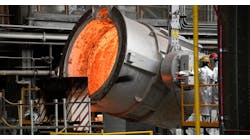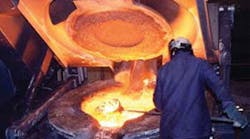While forging or fabricating metalworking tools by hand is an essential job at a smithy, it can be a wasteful and time-consuming chore for metalcasters, where in many cases the maintenance staff nevertheless fabricate a variety of hand tools for use in melting operations. These include slag and dross skimmers, scrapers, sampling spoons and stirrers, all cobbled together from scrap iron and steel. But, there is a better way.
Foundry tools produced from advanced ceramic materials are available for numerous melt shop tasks and offer important advantages over metal tools in almost every application. Unlike metal tools, ceramic tools for foundries and diecasters are engineered to perform well in contact with molten metal. They are not melted nor deformed by high temperatures, they resist slag and dross buildup, and they are lightweight. Moreover, unlike metal tools that require frequent replacement, ceramic foundry tools provide long service life. Also, when the real cost of producing and maintaining metal tools in-house is calculated, ceramic tools offer a lower overall cost.
Among the most useful and versatile ceramic hand tools are ladle bowls in sizes and shapes ranging from small bowls for taking molten metal samples to large bowls suitable for ladling metal into molds. Because of their non-wetting characteristics, i.e., their ability to resist surface penetration by molten metal and slag, they remain free of dirt and contamination allowing for cleaner samples. In the case of larger bowls used for filling small molds, they ensure cleaner metal pours. The thermal properties of the bowls’ clay-graphite material also help maintain the correct temperature for pouring accurate samples and molds.
Ladle bowls also are available with a drain hole that makes them highly effective for removing slag and dross from the surface of the metal bath in a furnace or ladle. Unlike conventional metal slag skimmers, ladle bowls efficiently collect and remove slag and dross without requiring large amounts of coagulants. Because of their lightweight, ceramic ladle bowls are better than metal skimmers where large quantities of slag have to be removed over an extended period of time.
Other ceramic tools for working with molten metal include small dip samplers with integral handles, stirrers designed to produce more homogeneous alloys, plain and paddle-bladed rods and scrapers for removing slag and dross.
Produced in many of the same materials as modern crucibles, ceramic products used with molten metal are characterized by exceptional resistance to erosion caused by metal and slag; high-resistance to thermal shock; and the ability of their non-wetting surface to resist penetration by molten metal and slag. They also offer very high thermal conductivity. These properties make advanced ceramic materials ideal for a range of products used with molten metal. They also include ceramic launders, pyrometer and thermocouple protection sheaths, heater sheaths, tubes, porous degassing lances, plunger mixers, ladle stoppers, nozzles, needle valves, downspouts, filling funnels, converter segments and cements and coatings.
Pre-formed ceramic launders are available in varying shapes and sizes to precisely match specific requirements for transferring molten metal between furnaces and from furnaces to casting ladles. Ceramic launders offer reduced maintenance requirements and longer service life than refractory cast or lined launders.
Because of the material’s high thermal conductivity, ceramic sheaths are widely used to protect pyrometers and thermocouples where accurate and responsive temperature measurement is required. Similarly, ceramic heater sheaths are used with electric resistance and gas-fired furnaces for the efficient transfer of heat to the metal in the furnace.
Ceramic tubes have numerous uses, including forming the teapot spout in ladles, cupola receiver entries and spouts and cupola slagging box siphons. They are used to transfer metal from furnace to ladle or ladle to mold.
Tubes with a threaded end for attaching to a gas supply adapter are used in aluminum degassing to pass nitrogen to the metal bath, to eliminate dissolved hydrogen that would cause porosity in castings. A range of ceramic degassing lances incorporate a porous end for smaller bubbles and better distribution of the nitrogen or argon gas in continuous degassing.
Ceramic plunger mixers also are used in degassing and in metal treatment applications, to plunge treatment tablets into brass or aluminum, and to stir in the reaction products in the production of ductile iron.
Ceramic ladle stoppers, needle valves and downspouts, and refractory nozzles are manufactured to close tolerances for bottom pouring and continuous casting. These products help to ensure an effective, non-stick seal and reseal process without leaks when closed.
Other ceramic foundry products include filling funnels, used in dosing furnaces; ductile iron converter segments; thermally conductive and high-performance cement; and zircon refractory coatings to protect refractory materials and metal tools against molten metal attack.
All molten metals present serious challenges to the materials used to melt, hold, process, and transfer them. But, modern ceramic materials provide an inherent ability to withstand the high temperatures associated with all molten metals. Together with their resistance to erosion and chemical attack, their high thermal conductivity, their physical strength, and their ability to resist thermal shock, these materials are providing foundry operators and diecasters with the tools they need to meet these challenges.
David T. Whincup is the marketing manager- Europe for Morgan Molten Metal Systems, U.K. Visit www.morganmms.com









